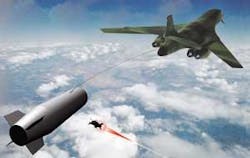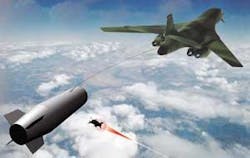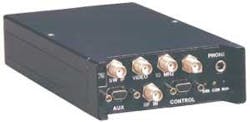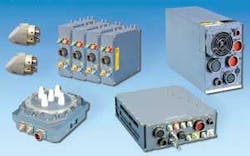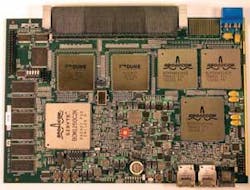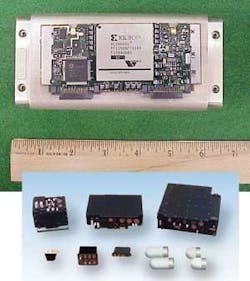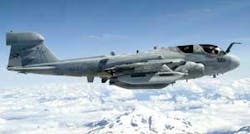Digital receivers power a new generation of electronic warfare
U.S. fighting forces use electronic warfare to detect and locate the enemy’s radar and radio signals, and turn the tables by using the enemy’s signals against him.
By Ben Ames
During the Cold War, military technology designers knew exactly what sort of challenge they faced with Soviet radar stations. Today, however, they face a more difficult job. Terrorists and insurgents tend to use low-tech equipment like commercial cellular phones instead of military-grade radios. They fire antiaircraft missiles from mobile launchers instead of from fortified bunkers.
Designers have reacted to the new threat with a major technology change-they are using digital radar receivers instead of analog units.
Like moving video storage from VHS to compact disc, the change is a major improvement for size, weight, and power-the three most common demands from military customers.
The technology has been around for several years, but given the slow pace of military systems design, it is only starting to fly on warplanes today.
Since the 1960s, the U.S. Air Force approach to dodging detection by enemy radar has been to escort bombers to their targets with signal-jamming aircraft such as E/A-6B Prowler or E/F-111A Raven.
The stealth technology of combat aircraft such as the F-117, B-2, F/A-22, and future F-35, make this job much easier, but no airplane is completely invisible to radar.
So as the aging Prowler nears the end of its life, and the Raven is already retired, Pentagon leaders have launched three major technology initiatives to replace them: the E/A-18G Growler, the B-52 Standoff Jammer, and unmanned aerial vehicles like the joint unmanned combat aerial system (J-UCAS) and the miniature air-launched decoy jammer variant (MALD-J).
By 2015, those new platforms could operate together in a layered system of airborne electronic attack, says John McCreesh, a systems architect for Northrop Grumman Electronic Systems in Baltimore.
These changes will arrive just in time to battle new enemy radar tactics. Integrated air defense systems (IADS) are becoming increasingly sophisticated, using networked and layered defenses, with defensive surface-to-air missile sites and redundant command and control. Today U.S. pilots must determine which radars are real, which are decoys, and which are surface-to-air missile launchers.
The goal of modern airborne electronic attack is to slow the enemy kill chain through a process Pentagon planners call D5: deny, degrade, deceive, disrupt, or destroy enemy air defenses.
Air Force planners will use these new tools in a layered approach. The leaders farthest from the battlefield will sit in a combined air operations center (CAOC). Closer to the scene, an E-10A MC2A (multisensor command and control aircraft) will track targets and provide battle management and local command and control. Even closer, the new B-52 standoff jammer will fly in a holding pattern, using its high-altitude to monitor radar signals while staying outside enemy missile range.
Closer and lower, the EC-130 Compass Call, RC-135 Rivet Joint, or RC-12 Guardrail Common Sensor aircraft will direct local operations as E/A-6B or E/A-18G jammers escort manned strike aircraft such as the B-2, F/A-22, or F-35 to their targets. Closest of all, unmanned aircraft like the J-UCAS and MALD will jam radar locations hidden by terrain from the gaze of the B-52.
Enabling technologies for the E/A-18G
One piece of electronics that makes the system work is Northrop Grumman’s AN/ALQ-218 tactical jamming receiver. The company delivered its fifth unit in August for a Navy E/A-6B Prowler, says John Vosilla, communications manager for Northrop Grumman Integrated Systems in Bethpage, N.Y.
As part of the current upgrade program called ICAPIII (the E/A-6B Improved Capability III), the ALQ-218 will replace the existing ALQ-99, with more precise passive radar threat detection, identification, precision geolocation, and jammer control. The component enables an E/A-6B pilot to locate enemy radar precisely enough to hit it with an AGM-88 high-speed antiradiation (HARM) missile.
The E/A-6B’s current AN/ALQ-99 is from EDO Corp. in New York. The system includes receivers and antennas on the airplane’s tail cap, and exciters and jamming transmitters in pods hung from the wings. Together, they suppress enemy air defenses by jamming radar, electronic data links, and communications.
Defensive options
That is a more active approach than purely defensive systems like EDO’s AN/ALQ-161 self-protection system on the B-1B bomber. That unit offers 360-degree receiving and jamming coverage, and tail-warning function to detect incoming missiles from behind, then dispense an ALE-50 towed decoy.
Made by Raytheon Co.’s Electronic Warfare Systems organization in Goleta, Calif., the ALE-50 works by attracting missiles to a better target than the airplane itself.
In April, Raytheon received a $32.5 million contract award from the U.S. Air Force Electronic Warfare Product Group, Warner Robins Air Logistics Center, Ga., for these decoys. Raytheon will build 1,249 decoys for the Air Force and 245 decoys for Navy aircraft, delivering the equipment through July 2007. Aside from the B-1B, the ALE-50 system is also used on the F-16 and F/A-18.
Another defensive tool used by pilots on Navy carrier-based F/A-18s is Raytheon’s AN/ALR-67(V)3 radar warning receiver. The 100-pound system enables aircraft to detect threats by identifying radar emitters through improved detection and processing.
In April, leaders at Naval Air Systems Command at Patuxent River Naval Air Station, Md., ordered 42 additional receivers for $44 million, to be delivered by September 2007. Three annual follow-on options call for 92 additional systems, valued at $116.8 million.
Other Navy F-18s-the F/A-18F Super Hornet and future E/A-18G Airborne Electronic Attack variant-will use Raytheon’s APG-79 Active Electronically Scanned Array (AESA).
In June, Boeing Integrated Defense Systems in St. Louis, ordered 190 radars under a five-year, $580 million contract. The APG-79 radar offers enhanced performance, including increased air-to-air tracking at very long detection ranges, higher resolution SAR (synthetic aperture radar) maps at longer ranges, almost simultaneous air-to-air and air-to-surface mode capability, and netcentric capability.
Offensive electronic warfare
For future offensive platforms, Navy leaders will install Northrop Grumman’s ALQ-218 in the E/A-18G Growler, Vosilla says. Navy leaders plan to buy 90 of these planes, phasing them into service beginning in 2009 to replace the E/A-6B by 2012.
As a two-seat replacement for the four-seat E/A-6B, the Growler will rely on automated systems to accomplish its mission with fewer humans in the loop. One airman will fly the converted F/A-18 Super Hornet and monitor situational awareness on a new cockpit monitor, while his crewman operates the electronic warfare systems.
“He can do that thanks to smart software, better displays, and faster algorithms to process the data. It changes the balance of what happens automatically and what the operator does,” says Vosilla.
Even as these systems improve, U.S. pilots face more complex radar threats. A modern enemy uses frequency-hopping radar to avoid jamming. So an ICAPIII-enabled Prowler follows those hops and remembers their pattern, then uses selective/reactive jamming, as opposed to the former broad-beam jamming approach.
Building a 21st century B-52
Engineers at Northrop Grumman are also competing to win an Air Force contract for the B-52 Standoff Jammer (SOJ).
In October, Air Force leaders at Wright Patterson Air Force Base, Ohio, will award the $256 million, 25-month system development deal to either Northrop Grumman or a team of Boeing and BAE Systems.
The full contract could be worth $3 billion, including plans to outfit 16 aircraft with full electronic warfare capability and 76 aircraft with an electronic surveillance package. The winner must offer operational capability by 2012, and complete the work by 2014.
The Northrop Grumman design would install a new crew station inside the airplane, and attach two 30- to 40-foot pods on the wings, each packed with phased- array multiband transmitters, says Dave Kratz, B-52 Standoff Jammer capture team leader for Northrop Grumman Electronic Systems in Baltimore.
Enabling the 50-year-old B-52 for electronic warfare will be a complex job on an airframe that has never done a mission with this much effective radiated power coming out of its jammers, says Nolan Schmidt, program director for the B-52 SOJ program with BAE in Nashua, N.H.
That high power is necessary because Air Force leaders want a platform with simultaneous jamming, decoy, and strike capabilities.
Another challenge will be to tie the system into the mobile battlefield network so it can cooperate with aircraft such as the E-10A MC-2A and the J-UCAS. That means the system will need real-time processing and open-architecture computing-difficult tasks on a platform whose high altitude and airspeed make it a more extreme environment than the C-130. Only fighter jets like the F-22 and F-35 represent more extreme environments for hosting electronics, he says.
The Boeing and BAE Systems proposed solution provides integrated receivers, jamming pods with preemptive and selective reactive jamming techniques, and mission-management software. Another crucial component will be the array of solid-state wideband power modules, used to generate sufficient power to jam distant signals.
COTS components
Engineers have traditionally defined four segments of electronic warfare: situational awareness, electronic protection, electronic surveillance, and electronic attack.
With the increased use of battlefield networks, they can begin to combine those missions.
“Today, radar warning receiver information is useful not just to a specific airplane, but when it is fed back into global information grid,” says Alan Howell, director of strategic and business development for Raytheon Electronic Warfare Systems in Goleta, Calif.
If three or more aircraft detect the same radar emission source, they can triangulate that signal to locate the source. They use an algorithm developed by engineers at the U.S. Defense Advanced Research Projects Agency (DARPA) in Arlington, Va., called AT3, for advanced tactical targeting techniques.
“Now you can use situational awareness data as a protective scheme or even to launch an attack based on that information alone,” Howell says. Faced with an enemy using mobile surface-to-air missile (SAM) sites and short-burst defensive radar, U.S. pilots can now perform lethal SEAD, the Pentagon term for suppression of enemy air defenses.
AT3 still faces technical challenges such as sorting a unique radar signal from the busy battlefield background, low-latency networking, fast data compression, real-time processing, and rapid and precise target geolocation. Raytheon designers are finding answers to most of those challenges in commercial off-the-shelf (COTS) components borrowed from the telecommunications and cellular telephone markets, such as fast field-programmable gate arrays (FPGAs) and digital signal processors (DSPs), he says.
Combined with advances in A-D and D-A converters, Raytheon can put more capability in smaller, lower-power systems. The latest digital receivers and processors can detect a greater variety of radio-frequency (RF) signals, from radars through cell phones, satellite phones, and walkie-talkies.
One example is the company’s ALR-69 digital radar warning receiver, scheduled for flight tests this year on the C-130 and F-16. In August, planners at the Warner Robins Air Logistics Center at Robins Air Force Base, Ga., granted Raytheon $10 million for an advanced-concept technology demonstration. Pilots will perform AT3 in 2007 when three F-16 Block 30 aircraft use the ALR-69A(V) to pinpoint a radar source.
The ALR-69A(V) receiver system used for the AT3 demonstration is an upgrade of the ALR-69(V), which is installed on U.S. Air Force C-130, F-16, A-10, and MH-53 aircraft.
Because its front-end processors, antennas, and apertures are getting smaller, the radar receiver can start to do some capabilities that used to happen only in back-end signal processing.
“That allows engineers to follow an effects-based approach-communications intelligence, communications jamming, signals intelligence, and signals jamming are all coming together. The missions are merging,” Howell says.
Electronic warfare network
Just as important as individual platforms like the B-52 and E/A-18G is a network between their powerful sensors.
“Things are different now than before the Soviet Union fell; the threat has gone from a traditional integrated air defense system (IADS) to a guy on the street with his cell phone,” says John Steckel, applications engineer for electronic warfare and electronic protection at BAE Systems.
Today’s approach to electronic warfare demands a range of abilities, from merely detecting a radar source as self-protection to identifying the source, tracking it, and locating it. The most precise EW suites can locate a radar source with enough precision to allow the pilot to launch a counter-attack with HARM missiles.
Air Force planners call this process the “kill chain,” or F2T2EA, an acronym for the six-stage target cycle of find, fix, track, target, engage, and assess. Digital receiver technology could help them achieve their goal of reducing that cycle to less than 10 minutes, to hit emerging and mobile targets.
At the same time, not all airplanes need this advanced capability. Certain missions are designed simply for effects confirmation and intelligence collection-whether signals intelligence, electronic intelligence, or measurement and signature intelligence.
That presents a challenge to electronics designers because they cannot pack one “black box” with common equipment for such different aircraft. So engineers are creating a flexible architecture, allowing them to port software and algorithms between different platforms.
The system is called ATAR, for advanced threat and response. It is in development by engineers at BAE Systems and at the Air Force Research Laboratory at Wright Patterson AFB, and could be ready for insertion into existing airplanes in two to five years.
For its most advanced abilities, the system relies on a digital receiver instead of the standard analog unit. That allows it to perform signals geolocation and specific emitter identification, says Steven Morais, deputy for BAE Systems’ RFEW business area in the electronic protection segment, also in Nashua, N.H.
BAE’s legacy analog radar receiver is the ALR-56C. Its digital replacement is called SOLER, an acronym for set-on low-cost expendable receiver/jammer.
In the meantime, many military aircraft still use analog receivers, including the F-15, F-16, A-10, C-17, and C-130, Steckel says. Designers are creating digital receivers only for the most advanced aircraft, such as the F/A-22 and F-35.
BAE engineers tested the ATAR system in August during a flight test at the Naval Air Weapons Station China Lake, Calif. Technicians installed the 185-pound broadband digital receiver system on a surrogate aircraft-the T-39 twin engine business jet-then collected simulated radio-frequency threats from ground based emitters.
The change to digital technology affects more than just the receiver.
“We’re working to replace an array of analog microwave devices with digital receiver circuitry, including A/D converters, FPGAs, and replacing magnetic tape with solid state storage. That miniaturization makes everything smaller and lighter,” Morais says.
The U.S. military has changed its mission in recent years from pounding Soviet tanks in Europe to swatting at swarms of terrorists in U.S. and allied cities. That new, decentralized enemy often communicates with hand-written notes and commercial cell phones, making them difficult to track with electronic warfare equipment that was designed to find intercontinental ballistic missiles.
“It used to be you could put a rack of equipment across the street from somebody’s embassy and get all the information you needed, but now we can’t predict where they’re going to be, or whether they’re among civilians,” says Alan Dietrich, president of the Intelligence Technologies division of DRS Technologies in Parsippany, N.J.
“Today’s equipment must be deployable, mobile, and networked back to a control center. Putting a collection center on a man’s back is a whole different challenge than putting it on a ship.”
The challenge has expanded from fighting an infrastructure-based enemy that used advanced military electronics to an enemy that uses commercial electronic devices.
“So rather than using large-scale collection points, the market is moving to distributed sensors-smaller, lighter, networked, on man-packs, UAVs, or ground sensors-all acting as collection nodes,” he says.
DRS engineers meet that need by reducing the size, weight, and power consumption of electronic warfare and signals intelligence gear, and giving it more independence. “Distributed sensors need some level of embedded processing, to analyze data in real time and intelligently network it to analysis points,” Dietrich says.
So company engineers are developing a new architecture called Octopus to control embedded digital signal processors by leveraging telecommunications and commercial networking technology, he says.
For this job, DRS has partnered with Broadcom Corp. in Irvine, Calif., to adopt a processor core from the commercial server market. DRS engineers will add ruggedized packaging and military backplane interconnect standards for data flow.
In the field, DRS customers will first use the company’s front-end tuners and receivers to capture radar signals and do the first round of processing. Then they will deploy Octopus with its high-speed networking chipset, commercial processor core, and new architecture.
The result is a system that can process signals in a range from high frequency to 40 Gigahertz in a box just 8 to 10 inches long-just one-quarter to one-eighth the size of what was on the market two or three years ago, he says.
“Now you can bundle four or eight tuner/receiver sets and focus on different bands. You can use parallel operations now, not sequential, to capture, process, and locate the signal in real time-and can even exploit it to classify the activity, to tell whether the person is blue, red, or white,” he says. Blue force are friendly, red forces are threats, and white forces are neutral.
“There are a lot of civilians in the Kosovos, Somalias and Baghdads of the world. And we never know where we’re going next.”
